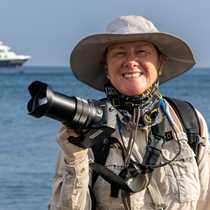Today is the last day of 2014. It was a very complete day, a long day, a strenuous day, and a thrilling day.
We began by sailing down the Bolivar Channel in the first hour of daylight, travelling from our previous night’s anchorage off Fernandina Island, heading to Urvina Bay on Isabela Island’s western side. It is found in a corner, between the volcanoes of Alcedo and Darwin, two of the five active volcanoes of the island. We have a very athletic group of folks on board, so it was no surprise to me that three groups formed to follow the long trail along the coast and through the forest. Clambering over sharp lava boulders was no big deal, and got them to the huge heads of coral that stand exposed to the air – for going onto 60 years now since the up-lift that took place in the early 1950s. They are now somewhat worn down by the elements, and overgrown with terrestrial vegetation such as Darwin’s cotton, poison apple trees, yellow cordia, velvetleaf, thornbushs, saltbushes, and palo santos.
The inside trail is smooth and easy, no rocks to watch out for, and this is where we found land iguanas, the large, bright orange and yellow variety. Flopped out on the ground, legs and arms spread as if they had stopped moving on the point of exhaustion. They made for wonderful photographic subjects. A close-up of a leg brings the image to mind of a medieval knight wearing chainmail gloves.
Back at the beach there was a feeding frenzy going on that had many of us rushing to get our masks on: almost a dozen penguins and three brown pelicans fishing a dense school of small anchovies, all happening within a few feet of the beach! This is NOT a frequent sighting, especially the part underwater that we could see: the pelicans would dive into the water into the school of fish; the penguins would come rushing over, and in a flurry of whitewater, bubbles, feet, bills, and rumps, would try to steal fish right out of the pelican’s beaks before it could get all the water out and swallow the catch. For me – after almost thirty years – a moment to remember!
To celebrate the visit and the heating up of the morning, I offered a “New Year’s Megaswim” back to the ship of 700 yards! 640 meters! 2,100 feet! 0.4 miles! 0.6 kilometers! And Clare was back first, no fins, no mask; as a competitive swimmer back home…she showed us how it should be done. Wow!
The afternoon was spent once more getting prepared for our group’s favorite sport – snorkeling! That went very well indeed, with flightless cormorants, penguins, and the serene green sea turtles feeding on algae. The second half of the afternoon was also filled: a full group of kayakers departed on their adventure along the cliffs of Tagus Cove, while two groups landed and hiked up the ravine bed, the 100 wooden steps, and along the rim of the crater to the lookout. There is nothing quite as iconic as the view from the top: over an expanse of desolate lava to the north towards the highest point in the archipelago, Wolf Volcano. Then south over Darwin Lake and into the cove where the National Geographic Islander was peacefully at anchor.
The Zodiac riders went north along the coast and discovered designs in the tuff cone layers, flightless cormorants, sea lions, penguins, and even a delightful small hawksbill sea turtle wearing a pink-encrusted Murex shell on its back (appropriate for the New Year’s party dress code). Wandering our way out into the Bolivar Channel in preparation for our return home, we encountered ocean sunfish (and got good looks at their dorsal fins), glimpses of some kind of shark cruising just below the water line, and Mobula rays jumping and flipping in a spectacular sunset over Fernandina Island.
It is the last evening, of the last day, of 2014. We are planning to enjoy the evening festivities while underway to our next destination. Tomorrow will be another day filled with wonder, but it will also be the beginning of a new year. We humans have marked time for our convenience, for harvests, for plantings. The wildlife of Galapagos also have their seasons, however based more on the subtle changes in temperature and humidity, on land and in the ocean. Here in Galapagos we are transitioning into the warm season. All are expecting rains to fall and food supplies to vary; abundance on land, scarcity in the sea, at least for a few months. Who really can predict what will happen in 2015? We can only wait and see.







